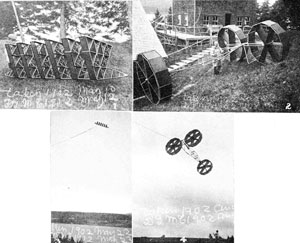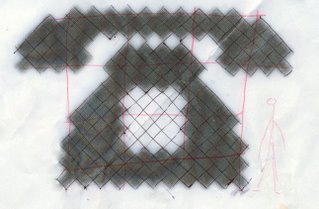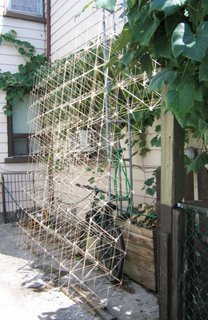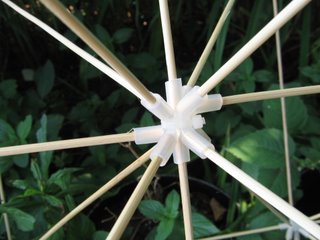


Archives
Subscribe to Posts [Atom]
Bell Kite Project Blog
I am building a huge kite inspired by Alexander Graham Bell's historical models.Framework Complete
Sunday, July 29, 2007


 I've mostly completed the kite framework. I'm including an illustration that shows what the kite will look like with covers. If you look closely you can see a person drawn in for scale. I've also included photos of the framework hanging against the house.
I've mostly completed the kite framework. I'm including an illustration that shows what the kite will look like with covers. If you look closely you can see a person drawn in for scale. I've also included photos of the framework hanging against the house.I began construction of the framework in the back yard, but it got too big for the yard, and so I pulled the kite up the side of the house and built along the bottom edge, lifting the kite bit by bit as I filled in rows. There's something relaxing about the patterns of spars and connectors. As I got more experience I started noticing subtleties about how connectors and spars worked together. I image that the the framework construction process is similar to knitting with its slow repetition of pattern.
Right now the framework is two cells deep. I'm not sure if I should make it thicker, either uniformly or in places. When viewed from the ground during flight, the kite will appear fairly two dimensional, so that's make thickness somewhat irrelevant. I've already sunk a lot of time and hand labour into the kite, and I'm a bit loath to add any more cells at this point. On the other hand, the kite might be stronger if it's thicker. Also I really admire the solid consequentiality of Bell's kites.
Kite Construction
Friday, July 27, 2007


Here are the basic facts. The kite will be about 16 feet wide and 12 feet tall. It will be shaped like a telephone. It will be built out of about 500 cells. I'm making cells of bamboo BBQ skewers joined with silicon tubing connectors that are held together with cable ties. The covers are made of polypropylene film and held on the framework with scotch tape. I plan to reinforce the structure with fibreglass tubing.
Here are some photos. The first photo shows a silicone tubing connector.
The second photo shows how the bamboo skewers are held in place by the connector. I tried about 30 different types of plastic tubing until I found one that had the right size and stickiness to hold the bamboo skewers firmly in place.
Strangely it was difficult to get this tubing into Canada. McMaster-Carr wouldn't ship it to Canada, and when I told them to just ship it to the US instead, they refused. Since they knew that I was going to bring the tubing to Canada, they wouldn't ship it to me in the US. This smells like irrational terrorism fear to me.
Anyway I simply cancelled my order and placed another other order for the exact same items without telling them that I was planning on taking the tubing north. That resolved the problem and everyone was happy.
The third image shows a cell with the polypropylene cover.
Comments:
<< Home
Hi Amos,
It's exciting to see you kite project get off the ground!
Your connector system is quite ingenious, when I first looked at the blog I wondered if you had them moulded or formed. Now I see you custom made them. Great solution!
I can see the frame in the background of the picture, and I really get a sense of the scale. Amazing!
/brenda
It's exciting to see you kite project get off the ground!
Your connector system is quite ingenious, when I first looked at the blog I wondered if you had them moulded or formed. Now I see you custom made them. Great solution!
I can see the frame in the background of the picture, and I really get a sense of the scale. Amazing!
/brenda
Hello,
We "blown away" by the scope of this project, particularly by the size of the kites.
Will you fly it to Nova Scotia?
Jim
Post a Comment
We "blown away" by the scope of this project, particularly by the size of the kites.
Will you fly it to Nova Scotia?
Jim
<< Home
Introduction
Thursday, July 26, 2007

I'm building a very large cellular kite inspired by the kites Alexander Graham Bell built about one hundred years ago. I've decide to try recording information about this project in "blog" format as the kite evolves over the next month.
Bell built some amazing kites. He had a workshop in Nova Scotia that created a large variety of cellular kites around the turn of the century. He was a participant in the race for flight, though not a very successful one. His kites looked beautiful, but they weren't great fliers. However, the triangular grids he pioneered became popular much later as an architectural form. I really like the way Bell's kites don't have the appearance of flying machines. They look like crystals or space ships.
I've been teaching a graduate architecture seminar "Flying Machines Invention Workshop" at University of Waterloo School of Architecture through the Render visiting professor project. The kite project grew out of my research for the class.
My plan is to finish the kite in a few weeks, because I'm going to take it out to Nova Scotia for Bell Cygnet Kite Centennial event in Baddeck. The event will celebrate Bell's kite projects at the historical Bell estate.